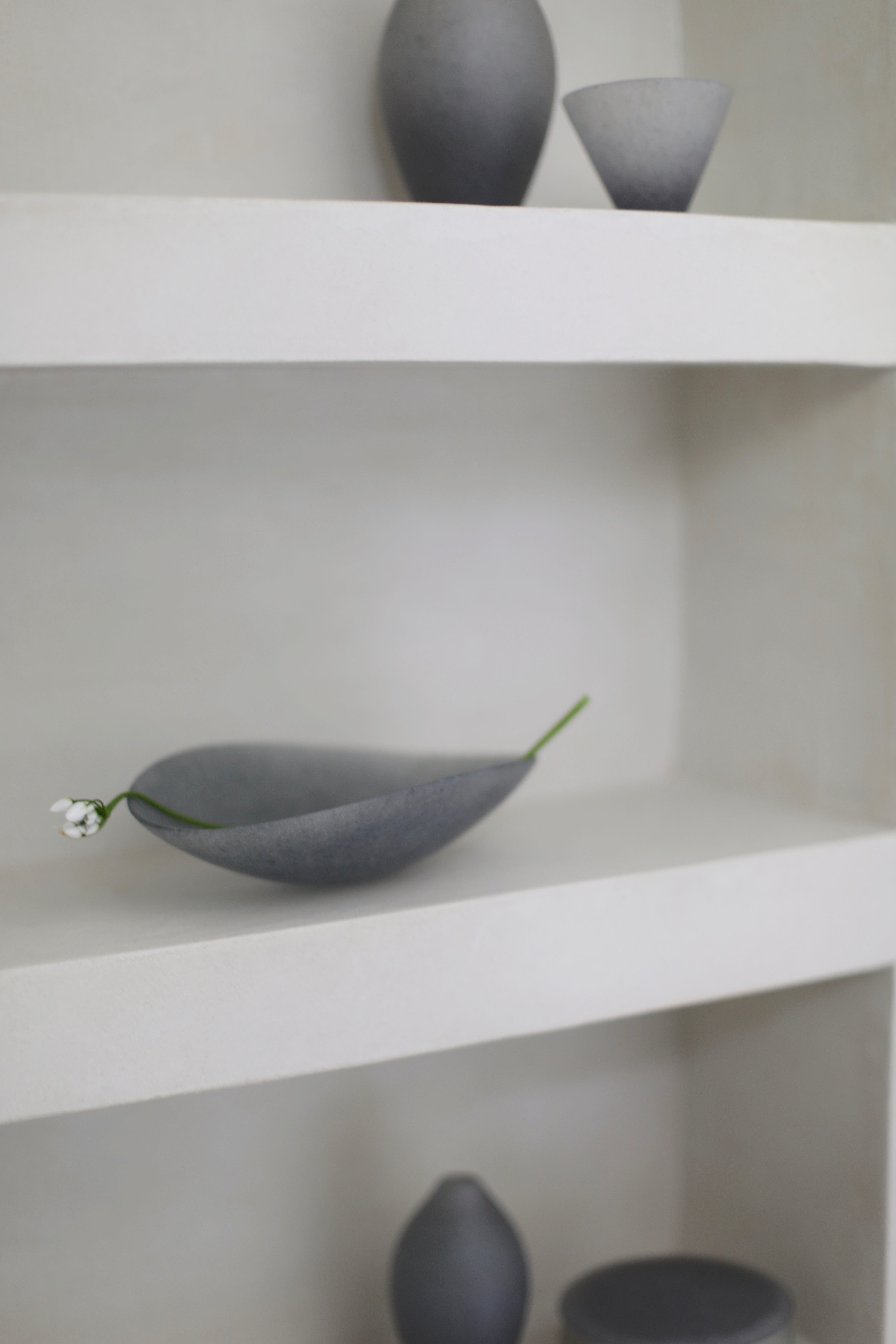Like a still life painting, these ceramic compositions invite slow, mindful attention. They are less about telling a story and more about noticing: the weight of a form, the trace of glaze, the way one piece settles beside another to create something new, simply through proximity.
Each work holds its own distinct identity, yet when grouped together, subtle relationships emerge. A shared sensitivity to material and form allow the pieces to resonate, even in their differences.
Rather than isolating each object, we present them as a collective to encourage a different way of seeing. One that considers not only what each piece is, but how they speak to one another.

A quiet dialogue unfolds between materials and makers. Kin Leung’s porcelain teapot and cup, finished in soft off-white and accented with a warm brass handle, sit in harmonious contrast to Takahashi McGil’s Shiro-Urushi Ash Bowl. The bowl’s pale blue surface, carved with intricate texture, evokes both water and wood grain. Leung, a London-based ceramicist, balances traditional craftsmanship with serene modernity, inviting us to slow down and savour. The collaborative duo Takahashi McGil blends Japanese and Western sensibilities, revering natural materials and timeless function. Their ash bowl, finished with centuries-old urushi lacquer techniques, carries both warmth and stillness. Together, these pieces create a setting that celebrates the subtle, tactile, and beautifully imperfect rhythms of daily ritual.

Tetsuya Ozawa’s layered surfaces, dusted white slip over dark Tokoname clay, have a softness that feels almost atmospheric. The gently brushed surface suggests quiet erosion over time. In contrast, Louise Egedal’s carved stoneware vessels introduce sharper marks. Thrown on the wheel, then chiselled and brushed using the Japanese Hakeme technique, her rich earthy browns are inscribed with fine lines and ridges. Louise calls her aesthetic “Nordic Wabi-sabi”, a fusion of Japanese imperfection and Danish minimalism. Their conversation is one of surface and rhythm, two softly spoken languages.


Works by Gaku Nakane, Kenta Anzai, and Josephine Cottrell offer another quiet exchange. Nakane’s sculptural vessels feel discovered rather than made, shaped by memory and landscape, holding traces of something ancient and familiar. Anzai’s moon jars, dark and polished, introduce a deeper stillness. Built over time, sanded and lacquered by hand, they reflect light with quiet intensity, speaking to patience and care. Josephine Cottrell’s abstract painting adds another dimension, hinting at nature without defining it. The fluid transitions of tone and space echo the complexity of Anzai’s vessels. Together, these artists share a sensitivity to material and process. Their works feel spacious, shaped by restraint, time, and trust in subtlety.

Wu Wei Cheng’s tea-ware brings ritualistic energy to the arrangement. Made with clarity and precision, each piece reflects the rhythm of the tea ceremony, where form and function are inseparable. Cheng invites pause and presence, embodying still life not just as visual arrangement, but as lived experience.

Will Papworth’s moon jar anchors the scene with its soft monumentality, a form steeped in tradition, yet unmistakably contemporary in its meditative stillness. Alongside it, Youyou Wang’s miniature teapot is a study in intimacy and proportion, a distilled object of impeccable precision. Carina Ciscato’s lidded form draws its strength from asymmetry, angles and curves meeting architectural clarity with organic irregularity, and Tanya McCallin’s bowl, pure line and volume, contemplative in its simplicity and deeply human in its touch.
Together the lines of each form shift with the light, shadows emphasising edges, softening curves, and revealing the quiet clarity of each piece.

These compositions do not offer fixed meanings. Instead, they invite open interpretation, revealing themselves through tone, contrast, and rhythm. Each shift in material or scale draws the eye to move, pause, and return.
Styled with the same sensitivity guiding our exhibitions, balancing openness with intention, these arrangements evoke a domestic sense, elevated. They are pieces to live with, to handle, to revisit.
This is more than a collection of ceramics. It is a study in relationships; how distinct voices come together through shared values of clarity, simplicity, and form. We hope it invites you to see these works as part of your own still life compositions; not static, but evolving. An arrangement shaped by attention, curiosity, and the shifting rhythms of daily life.

